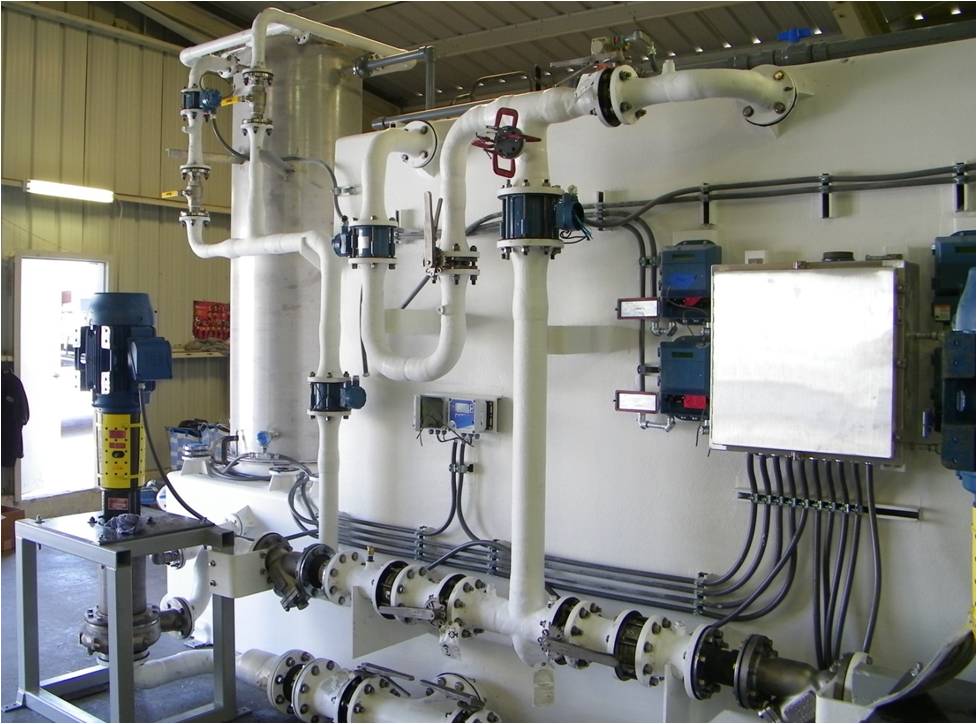NOx Scrubbers
Application: NOx Scrubbers
NOx represents a family of seven compounds, the most prevalent being nitric oxide (NO) and nitrogen dioxide (NO2). Both compounds form ozone (O3) in the atmosphere through photochemical reactions. NOX is a precursor to smog and a significant contributor to regional haze. The EPA regulates NO2 as a surrogate for NOx through National Ambient Air Quality Standards (NAAQS). Nearly 50% of all NOx is generated by automobiles and mobile sources. Twenty percent comes from electric power plants and 30% come from everything else.
For a variety of reasons, NOx scrubbers are more complicated than typical acid gas scrubbers. Longer residence times and greater packing height are required. Multiple stages may be needed depending on the design requirements and facility preferences. The design of the chemical storage and delivery system is more complex for safely handling and storing multiple chemicals involved with scrubbing. A water treatment system is needed to safely manage scrubber blowdown. The scrubbers operate at high pH which makes it more challenging to maintain ORP and pH meter calibration. Because of high operating pH, wet scrubbers are generally not suitable for combustion exhaust. High CO2 concentration from combustion compete for NaOH and lead to excessive chemical consumption.
Despite these complexities, there are several applications that use wet scrubbers for NOx abatement. These include nitric acid manufacturing, metal finishing operations, and other types of chemical processing. Most NOx scrubbers are designed to remove NO2 only because NO2 has a brownish color that yields a visible plume and is more toxic than NO. NO, on the other hand, is a colorless gas with no visible plume. NO2 has a threshold limit value (TLV) for workplace exposure of just 3 ppmv compared to 25 ppmv for NO.
NO2 can be converted to nitrogen gas (N2) by a reducing agent in a packed bed reduction stage. Sodium hydrosulfide (NaHS) is a common reducing agent and provides the most compact scrubber footprint. Caustic (NaOH) is consumed in the reduction stage to maintain a high pH (>12.5) where NaHS reactions take place.
In cases where NO removal is necessary, NO is first converted to NO2 in a separate packed bed oxidation stage before the reduction stage. Ozone or chlorine dioxide (ClO2) can be used for the oxidation reactions. ClO2 can be generated in the packed bed by adding sulfuric acid (H2SO4) acid to a solution of sodium chlorite (NaClO2).
Although the use of NaHS provides the quickest reaction times and smallest footprint, a drawback is the potential for hydrogen sulfide (H2S) odors due to reactions of NaHS with H2O to yield NaOH and H2S. To minimize H2S odors, the scrubber must be operated at high pH with the addition of NaOH. Odor problems are more likely to occur when pH probes get out of calibration or if the scrubber gets overdosed with NaHS. Some facilities take the additional step of adding a caustic odor control stage after the reduction stage. A NOx scrubber using NaHS can therefore have up to three stages depending on the requirement for NO removal, concerns for hydrogen sulfide odors, and the ability of the facility to maintain a high pH.
Another consideration for NOx scrubbers is blowdown treatment. A water treatment system (WTS) is generally needed to treat blowdown streams of varying chemical compositions. A typical WTS will be a multi-stage system incorporating an initial oxidation step with active chemical neutralization stages. The WTS consumes sulfuric acid (H2SO4), caustic (NaOH), and an oxidizing agent like peroxide (H2O2) or sodium hypochlorite (NaClO).
An alternative chemistry for NOx removal is hydrogen peroxide (H2O2). Reactions with H2O2 are much slower than other common scrubber reactions and require longer residence time. As a result, the size of the scrubber and the recirculation rates are much larger using H2O2. For this reason, H2O2 is not generally used for scrubber applications larger than 5,000 cfm. There is also a limit on NO removal which is dependent on the NO to NO2 ratio. The advantage of H2O2 is the use of a single chemical and single packed bed for NO and NO2 removal. The disadvantage is the requirement of larger footprint and recirculation rates, and limitations on NO removal dependant on the NO to NO2 ratio. Another disadvantage is that stainless steel is recommended for the scrubber vessel which is more expensive the fiber reinforced plastic (FRP). Care should be taken to evaluate the application to determine if H2O2 is the optimum choice for the scrubber.
Depending on the gas flow rate Envitech can use its rectangular packed bed scrubber design for multistage NOx scrubbers. This provides an advantage to simplify interconnect ductwork, increase pre-assembly and integration, reduce installation time and cost, and improve maintenance access and safety. Contact Envitech directly for more details.
Exhaust Sources: Nitric acid manufacturing, metal finishing operations, chemical processing
EPA Standards: National Ambient Air Quality Standards (NAAQS)
Pollutants:
- NO
- NO2
Equipment
- Packed bed absorbers
- Water treatment systems





